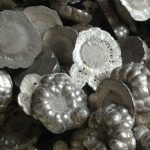Notice: Undefined index: sith_hide_share in /www/sites/alloy.wiki/index/wp-content/themes/likegoogle/single.php on line 32
Deprecated: get_settings is deprecated since version 2.1.0! Use get_option() instead. in /www/sites/alloy.wiki/index/wp-includes/functions.php on line 4862
High temperature titanium alloy
The world's first successful high temperature titanium alloy is ti-6al-4v, the service temperature of 300-350℃. Subsequently, IMI550, bt3-1 and other alloys with use temperature of 400℃ were developed successively, and IMI679, IMI685, ti-6246, ti-6242 and other alloys with use temperature of 450~500℃ were developed successively. At present, some new high temperature titanium alloys have been successfully used in aircraft engines. American ti-1100 alloy; Russian BT18Y, BT36 alloy, etc. In recent years, rapid solidification/powder metallurgy technology, fiber or particle reinforced composite material development of titanium alloy as high temperature titanium alloy development direction, so that the use of titanium alloy temperature can be increased to more than 650℃. McDonnell Douglas has developed a high-purity, high-density titanium alloy with rapid solidification/powder metallurgy technology that is equivalent to the strength of titanium alloys currently used at room temperature at 760℃.
Titanium alloys based on titanium aluminum compounds
Compared with normal titanium alloy, titanium aluminum compound sodium based Ti3Al (alpha 2) and TiAl intermetallic compounds (gamma) has the advantage of high temperature performance is good (using temperature, respectively 816 and 982 ℃) and antioxidant ability, good creep resistance and light weight (density is only 1/2 of nickel-based superalloy), these advantages make it a competitive aircraft engine and aircraft structural materials in the future.
High strength and toughness beta titanium alloy
Beta titanium alloy is the B120VCA alloy (ti-13v-11cr-3al) developed by Crucible company in the mid-1950s. Beta titanium alloy has good cold and hot processing properties, easy forging, rolling, welding, solid solution-aging treatment can obtain higher mechanical properties, good environmental resistance and strength and fracture toughness. Ti1023 (ti-10v-2fe-# al) is representative of the new type of titanium alloy with high strength and high toughness. This alloy is similar to the 30CrMnSiA high-strength structural steel commonly used in aircraft structural parts and has excellent forging performance. Ti153 (ti-15v-3cr-3al-3sn). The cold-processing performance of this alloy is better than that of industrial pure titanium. The tensile strength at room temperature after aging can reach more than 1000MPa. Beta 21S (ti-15mo-3al-2.7 nb-0.2 Si). This alloy is a new type of titanium alloy with oxidation resistance and ultra-high strength, developed by Timet division of American titanium metal company. It has good oxidation resistance and excellent cold and hot processing performance. Sp-700 (ti-4.5 al-3v-2mo-2fe) titanium alloy successfully developed by Japan steel tube corporation (NKK) has high strength, super plastic elongation up to 2000%, and the superplastic forming temperature is 140℃ lower than ti-6al-4v, which can replace ti-6al-4v alloy to manufacture various aerospace components by superplastic forming — diffusion connection (SPF/DB) technology. The tensile strength of bt-22 (ti-5v-5mo-1cr-5al) developed by Russia can reach over 1105MPA.
Flame retardant titanium alloy
Conventional titanium alloys tend to burn alkanes under certain conditions, which limits their application to a large extent. In view of this situation, many countries have carried out research on flame-retardant titanium alloy and made some breakthroughs. Alloy c (also known as T nominal component 50ti-35v-15cr (mass fraction), developed by qiang, is a flame-retardant titanium Alloy insensitive to continuous combustion, and has been used in F119 engine. Btt-1 and btt-3 are flame-retardant titanium alloys developed by Russia, both of which are ti-cu-al series alloys, and have quite good thermal deformation performance, which can be used to make complex parts.
Medical titanium alloy
Titanium is non-toxic, light in weight, high in strength and has excellent biocompatibility. It is an ideal medical metal material and can be used as implants for human body. At present, ti-6al-4v ELI alloy is still widely used in the field of medicine. However, the latter can precipitate extremely small amounts of vanadium and aluminum ions, which reduces the cellular adaptability and may cause harm to human body. As early as the mid-1980s, the United States began to develop aluminum – and vanadium – free biocompatible titanium alloys for orthopedics. Japan and Britain have also done a lot of research work in this field and made some new progress. Compared to the alpha + beta titanium alloy, beta titanium alloy has higher strength and better incision performance and toughness, making it more suitable for implantation. Five titanium beta alloys have been recommended for medical use in the United States. It is estimated that ti-6al-4v ELI alloy with high strength, low elastic modulus, excellent formability and corrosion resistance is likely to replace ti-6al-4v ELI alloy widely used in medical field in the near future.

Guest contributors are welcome at the Alloy Wiki.It is a weekly wiki and guide on alloy information and processing technology, while also about the vast array of opportunities that are present in manufacturing. Our team of writers consists of a Machining Material Supplier / Machinist / Tool and Die Maker, a Biomedical Engineer / Product Development Engineer, a Job Development Coordinator / Adjunct Professor, and a President and CEO of a manufacturing facility.
Link to this article:Atoms of titanium alloy plate and corrosion resistant titanium alloy
Reprint Statement: If there are no special instructions, all articles on this site are original. Please indicate the source for reprinting:Alloy Wiki,thanks!^^


